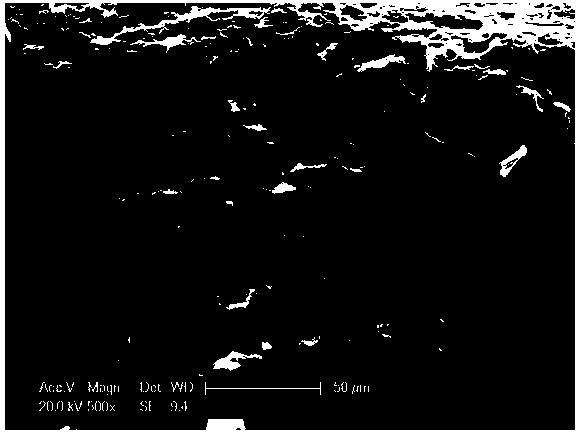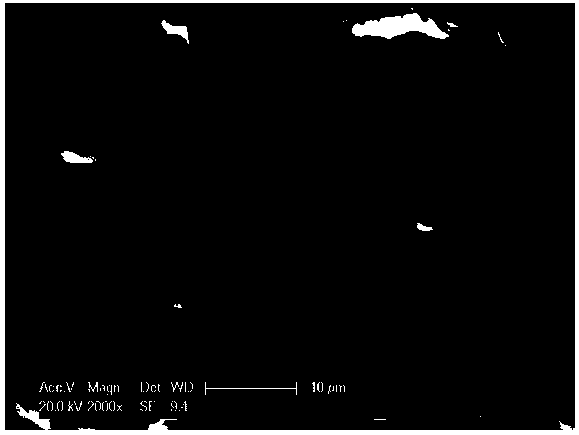Cellulose-based phenolic compound molecularly imprinted adsorbent and preparation method thereof
A phenolic compound, molecular imprinting technology, applied in alkali metal compounds, chemical instruments and methods, adsorption water/sewage treatment, etc. Adsorption performance, simple production process, and the effect of realizing high-value utilization
- Summary
- Abstract
- Description
- Claims
- Application Information
AI Technical Summary
Problems solved by technology
Method used
Image
Examples
Embodiment 1
[0088] The raw material components used in this embodiment are as follows:
[0089] Absorbent cotton: 0.62 kg;
[0090] Cellulose dissolving agent ([Bmim]Cl and dimethyl maple, the volume ratio of the two is 5:1): 24.8 kg;
[0091] Chloroacetyl chloride: 4.13 kg;
[0092] Cuprous bromide: 1.2 kg;
[0093] 2,2'-bipyridine: 1.26 kg;
[0094] Ascorbic acid: 0.36 kg;
[0095] Chloroform: 37.17 kg;
[0096] Methacrylic acid: 20.23 kg;
[0097] 2-Chlorophenol: 10.23 kg;
[0098] The specific steps are:
[0099] (1) Cellulose dissolution
[0100] 0.62 kg of pulverized absorbent cotton and 24.8 kg of cellulose dissolving agent were uniformly mixed, and stirred and dissolved at 80° C. for 1 hour under microwave-assisted conditions to obtain a homogeneous cellulose solution;
[0101] (2) Cellulose homogeneous esterification modification
[0102] Add 4.13 kg of chloroacetyl chloride to the cellulose homogeneous solution, adjust the temperature to 40°C, and stir for 1 hour. Afte...
Embodiment 2
[0125] The raw material components used in this embodiment are as follows:
[0126] Absorbent cotton: 0.89 kg;
[0127] Cellulose dissolving agent ([Emim]Cl and N,N dimethylformamide, 3:1): 35.61 kg;
[0128] Bromoisoacyl bromide: 5.46 kg;
[0129] Cuprous chloride: 3.01 kg;
[0130] N, N, N', N', N"-pentamethyldiethylenetriamine: 0.82 kg;
[0131] Stannous octoate: 1.04 kg;
[0132] Toluene: 23.81 kg;
[0133] 4-vinylpyridine: 18.49 kg;
[0134] 4-Chlorophenol: 10.87 kg;
[0135] The specific steps are:
[0136] (1) Cellulose dissolution
[0137] 0.89 kg of pulverized absorbent cotton and 35.61 kg of cellulose dissolving agent were uniformly mixed, and stirred and dissolved at 80° C. for 2 hours under microwave-assisted conditions to obtain a homogeneous cellulose solution;
[0138] (2) Cellulose homogeneous esterification modification
[0139] Add 5.46 kg of bromoisoacyl bromide to the cellulose homogeneous solution, adjust the temperature to 40°C, and stir for 2 h...
Embodiment 3
[0162] The raw material components used in this embodiment are as follows:
[0163] Masson pine pulp: 0.48 kg;
[0164] Cellulose dissolving agent ([Amim]Cl and N,N dimethylacetamide, 2:1): 19.2 kg;
[0165] 2-bromoisobutyryl bromide: 2.82 kg;
[0166] Nail bromide: 2.69 kg;
[0167] 2-Pyridine formaldehyde n-propylamine: 1.39 kg;
[0168] Vitamin C: 1.25 kg;
[0169] n-heptane: 23.59 kg;
[0170] 2-vinylpyridine: 24.26 kg;
[0171] 2-Nitrophenol: 24.32 kg;
[0172] The specific steps are:
[0173] (1) Cellulose dissolution
[0174] Uniformly mix 0.48 kg of masson pine pulp with 19.2 kg of cellulose dissolving agent, and stir and dissolve at 80° C. for 2 hours under microwave-assisted conditions to obtain a homogeneous cellulose solution;
[0175] (2) Cellulose homogeneous esterification modification
[0176] Add 2.82 kg of 2-bromoisobutyryl bromide to the cellulose homogeneous solution, adjust the temperature to 40°C, and stir for 2 hours. After the reaction, pour i...
PUM
 Login to View More
Login to View More Abstract
Description
Claims
Application Information
 Login to View More
Login to View More - R&D
- Intellectual Property
- Life Sciences
- Materials
- Tech Scout
- Unparalleled Data Quality
- Higher Quality Content
- 60% Fewer Hallucinations
Browse by: Latest US Patents, China's latest patents, Technical Efficacy Thesaurus, Application Domain, Technology Topic, Popular Technical Reports.
© 2025 PatSnap. All rights reserved.Legal|Privacy policy|Modern Slavery Act Transparency Statement|Sitemap|About US| Contact US: help@patsnap.com



